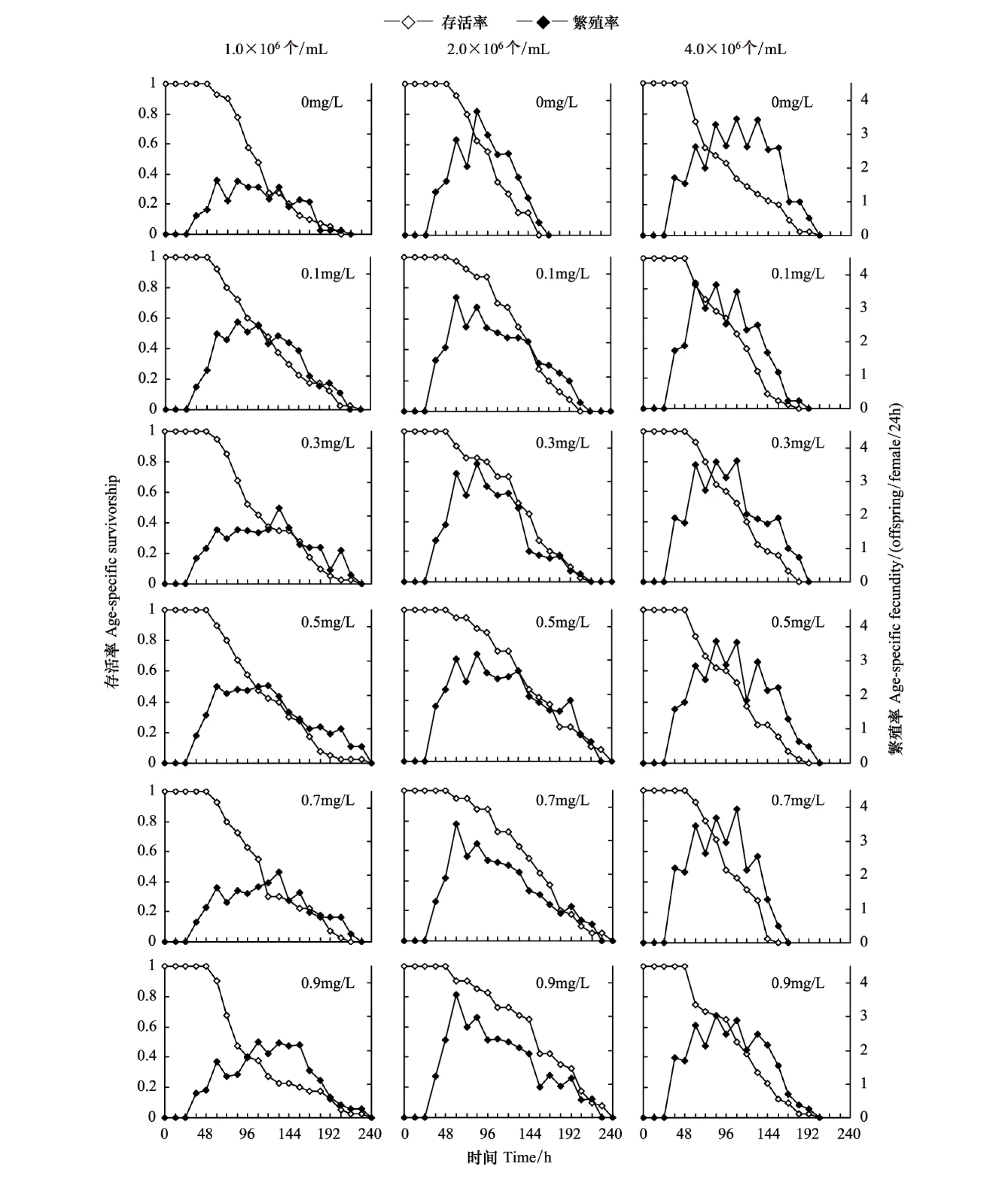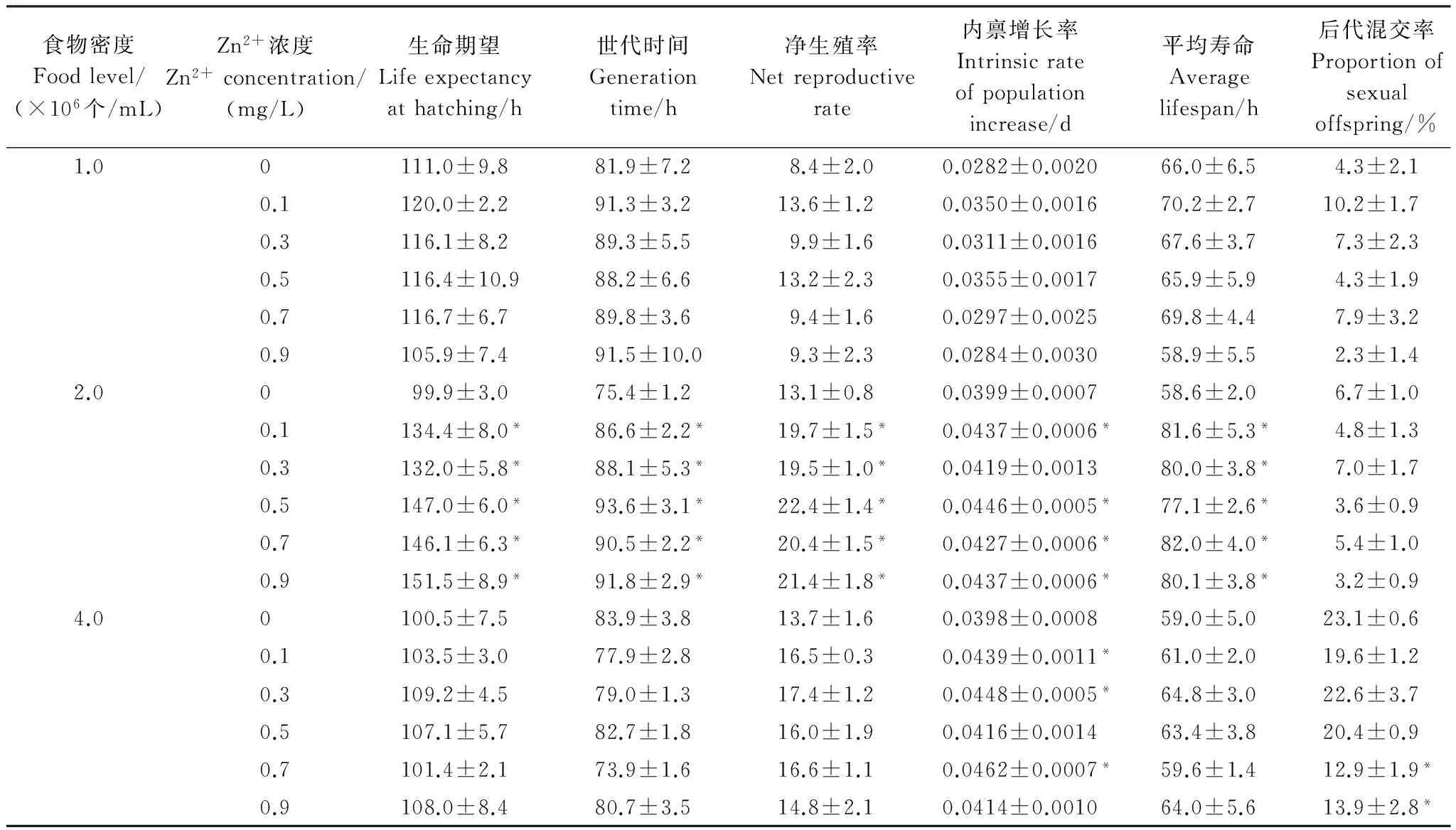不同藻密度下Zn2+ 浓度对萼花臂尾轮虫实验种群增长参数的影响
赵清清, 席贻龙, 李志超, 潘 玲
安徽师范大学生命科学学院, 安徽省高校生物环境与生态安全省级重点实验室, 芜湖 241000
不同藻密度下Zn2+浓度对萼花臂尾轮虫实验种群增长参数的影响
赵清清, 席贻龙*, 李志超, 潘 玲
安徽师范大学生命科学学院, 安徽省高校生物环境与生态安全省级重点实验室, 芜湖 241000
为了比较不同食物密度下污染物浓度对受试生物的慢性毒性,筛选出以轮虫为受试生物对水环境中Zn2+污染进行监测的敏感指标,在不同斜生栅藻(Scenedesmusobliquus)密度(1.0×106、2.0×106和4.0×106个/mL)下不同浓度(0、0.1、0.3、0.5、0.7、0.9 mg/L)的Zn2+对萼花臂尾轮虫(Brachionuscalyciflorus)实验种群增长参数的影响。结果表明,25℃以及1.0×106、2.0×106和4.0×106个/mL藻密度下Zn2+对萼花臂尾轮虫的24 hLC50值分别是6.647、8.102和5.873 mg/L。与各食物密度下的对照组相比,当食物密度为1.0×106个/mL时,各浓度的Zn2+对萼花臂尾轮虫的各种群增长参数均无显著性影响(P>0.05)。当食物密度为2.0×106个/mL时,各浓度的Zn2+均显著延长了轮虫的生命期望、世代时间和平均寿命,提高了轮虫的净生殖率;除0.3 mg/L外,其他浓度的Zn2+显著提高了轮虫的种群内禀增长率。当食物密度为4.0×106个/mL时,0.1、0.3和0.7 mg/L的Zn2+显著提高了轮虫的种群内禀增长率,0.7和0.9 mg/L的Zn2+显著提高了轮虫的后代混交率。藻密度对轮虫的生命期望、世代时间、净生殖率、种群内禀增长率、平均寿命和后代混交率均有极显著性影响(P<0.01),Zn2+浓度对轮虫的生命期望、世代时间、净生殖率、种群内禀增长率和后代混交率均有极显著性影响(P<0.01),藻密度和Zn2+浓度之间的交互作用对轮虫的生命期望、种群内禀增长率和后代混交率均有显著性影响(P<0.05)。2.0×106个/mL食物密度下,Zn2+浓度与轮虫的生命期望、世代时间、净生殖率和平均寿命之间具有显著的剂量-效应关系;4.0×106个/mL食物密度下,Zn2+浓度与轮虫的后代混交率间也具有显著的剂量-效应关系。
Zn2+浓度; 斜生栅藻密度; 萼花臂尾轮虫; 种群增长参数
随着工农业生产的快速发展,各种重金属通过冶金和电镀等工业废水、金属设备的腐蚀以及上游矿产地区的地表径流等多种途径进入水体,污染水生生物,并通过食物链的富集作用危害到人类的健康。锌不溶于水,但是锌盐如氯化锌、硫酸锌、硝酸锌等,则易溶于水。和铅、隔和汞等重金属不同,锌是所有生物有机体新陈代谢必须的[1]。但是,高浓度的锌会影响包括浮游动物在内的大多数水生动物的存活和生殖[2- 3]。水体中锌含量过高对植物生长也是有害的[4]。可食用的植物,如果锌含量过高,对人体健康具有潜在的危害[4]。锌影响哺乳动物的内分泌过程和生殖[5],一定程度的锌富集可能有益于发头裸腹溞(Moinairrasa)的生殖[6]。因此研究锌对水生生物存活、生殖和种群增长等的影响具有重要的意义。
轮虫具有世代时间短、个体小、繁殖快、易培养、对常见的毒物敏感性强等特点,在水生态系统的物质循环和能量传递过程中具有重要的作用;自20 世纪70 年代起便被应用于水生态毒理学研究。迄今为止,以轮虫为受试生物研究重金属等的急性和慢性毒性作用已有较多的报道[7- 13]。考虑到环境中食物密度的时空变化可能会对急性毒性实验结果产生影响,Azuara-Garcí等[14]、Sarma等[15]、Nandini[16]等、石娟等[17]以轮虫为受试生物研究了重金属污染物浓度和藻类等食物密度对轮虫实验种群增长参数的影响,得到了诸如平均寿命、净生殖率、世代时间和种群增长率等可用于重金属污染物生物监测的指标;但有关不同藻密度下Zn2+浓度对萼花臂尾轮虫实验种群增长参数的影响还未见报道。本文以淡水中常见的萼花臂尾轮虫为受试生物,采用生命表实验方法,研究了3 种藻密度下不同浓度的Zn2+对轮虫实验种群增长参数的影响;旨在筛选出敏感的指标用于水环境中Zn2+污染的生物监测。
1 材料与方法
1.1 轮虫的来源和培养
受试生物萼花臂尾轮虫采于芜湖市镜湖,实验室内以曝气72 h后的自来水(pH 值 7.0)[18]为培养液,以HB- 4培养基[19]培养的、处于指数增长期的斜生栅藻为饵料对其进行克隆培养。实验前,将轮虫置于(25±1) ℃、自然光照的恒温培养箱内进行1 周时间的预培养。期间,每天投喂密度分别为1.0×106、2.0×106和4.0×106个/mL的斜生栅藻并更换轮虫培养液一次,同时通过去除一部分个体使轮虫种群始终处于指数增长期。
1.2 测试液的配置
实验所用的ZnCl2由上海化学试剂总厂生产,分析纯(纯度为98.0%)。实验中使用的重金属量为化合物中Zn2+含量。测试液按母液稀释法配置,实验前用蒸馏水配置20.0 g/L的原液,再用蒸馏水稀释成100.0 mg/L的母液,于4 ℃冰箱中备用;母液3 d配制1 次。实验时用曝气自来水将其配制成所需浓度的测试液。
1.3 急性毒性试验
为选择合适的慢性实验毒物浓度,生命表实验之前,先进行24 h急性毒性实验。根据正式毒性实验前1.0×106、2.0×106和4.0×106个/mL藻密度下的勘探实验结果,将Zn2+浓度按等对数间距设置为1.4、2.5、4.5、7.8和14.0 mg/L,1.8、3.2、5.7、10.0和18.0 mg/L,2.1、3.8、6.7、12.0和21.0 mg/L共3 组各5 个浓度梯度,每组另设一个空白对照组;实验在8 mL玻璃杯(使用前在相应浓度污染物中浸泡48 h)中进行,每杯中放入10 只龄长在4 h内的轮虫幼体和5 mL测试液,每组设置3 个重复。试验在(25±1) ℃、无光照的恒温培养箱中进行,24 h后观察记录每个玻璃杯中轮虫的死亡数目,采用概率单位法求得24 hLC50值。
1.4 生命表实验
依据急性毒性实验得出的各藻密度下的LC50值的1/8—1/100[6],将Zn2+浓度设置为0、0.1、0.3、0.5、0.7和0.9 mg/L,藻密度设置为1.0×106、2.0×106和4.0×106个/mL。将孵化出的龄长在4 h内的轮虫幼体挑出作为受试母体,并加入5 mL测试液 (其中分别含有相应浓度的Zn2+和相应密度的斜生栅藻);每个组合设置4 个重复,每个重复使用10 只轮虫幼体。实验在(25±1) ℃、自然光照的恒温培养箱中进行。实验过程中,每12 h观察1 次并记录母体的存活数和孵化出的幼体数,移去死亡个体,并将新生幼体移至另一玻璃杯中继续培养,待其产卵后确定雌体类型,用于计算轮虫一生所产全部后代中的混交雌体比例。每间隔24 h更换1次含有相应密度的藻类食物的测试液。实验进行至轮虫母体全部死亡为止。
1.5 研究参数的定义与计算方法

1.6 数据处理
采用SPSS 16.0分析软件和Excel对数据进行分析,对所得数据作正态性检验后,对符合正态分布的各组数据通过单因素方差分析(one-way ANOVA)和多重比较(LSD检验)分析各浓度组与空白对照组间的差异显著性,通过双因素方差分析检测Zn2+浓度、斜生栅藻密度及其交互作用对轮虫各种群增长参数的影响,对Zn2+浓度与各种群增长参数之间的关系进行回归分析。
2 结果与分析
2.1 不同食物密度下Zn2+对萼花臂尾轮虫的急性毒性
急性毒性实验结果显示,(25±1)℃、无光照,食物密度分别为1.0×106、2.0×106和4.0×106个/mL时,Zn2+对萼花臂尾轮虫幼体的24 hLC50值分别是6.647、8.102和5.873 mg/L,95%的置信区间分别为4.414—12.668、6.158—11.480和4.599—7.431 mg/L。
2.2 不同食物密度下Zn2+对萼花臂尾轮虫种群增长参数的影响
根据各食物密度和Zn2+浓度下萼花臂尾轮虫的存活率和繁殖率(图1)计算出的轮虫种群增长参数列于表1。统计分析结果表明,1.0×106个/mL食物密度下,Zn2+浓度对萼花臂尾轮虫的各种群增长参数均无显著性影响(P>0.05)。2.0×106个/mL食物密度下,Zn2+浓度对萼花臂尾轮虫的生命期望、世代时间、净生殖率、种群内禀增长率和平均寿命均有显著性影响(P<0.01)。4.0×106个/mL食物密度下,Zn2+浓度对萼花臂尾轮虫的种群内禀增长率和后代混交率均有显著性影响(P<0.05)。与各食物密度下的对照组相比,当食物密度为2.0×106个/mL时,各浓度的Zn2+均显著延长了轮虫的生命期望、世代时间和平均寿命,提高了轮虫的净生殖率;除了0.3 mg/L外,其他浓度的Zn2+显著提高了轮虫的种群内禀增长率。当食物密度为4.0×106个/mL时,0.1、0.3和0.7 mg/L的Zn2+显著提高了轮虫的种群内禀增长率,0.7和0.9 mg/L的Zn2+显著降低了轮虫的后代混交率(表1)。

图1 不同食物密度和Zn2+ 浓度下萼花臂尾轮虫的存活率和繁殖率Fig.1 Survivorship and fecundity of Brachionus calyciflorous exposed to different concentrations of Zn2+ at three food densities
表1 不同食物密度和Zn2+浓度下萼花臂尾轮虫的种群增长参数(均数±标准误)
Table 1 Population growth parameters of Brachionus calyciflorous exposed to different concentrations of Zn2+at three food densities

* 表示与同一食物密度下的对照组相比有显著性差异
2.3 食物密度和Zn2+浓度对萼花臂尾轮虫种群增长参数的影响
双因素方差分析显示,食物密度对轮虫的所有生命表统计学参数均有显著性影响(P<0.01),Zn2+浓度对轮虫的生命期望、净生殖率、内禀增长率和后代混交率均有极显著性影响(P<0.01),食物浓度和Zn2+浓度之间的交互作用对轮虫的生命期望、种群内禀增长率和后代混交率均有显著性影响(P<0.05)。
2.4 不同食物密度下萼花臂尾轮虫种群增长参数与Zn2+浓度间的关系
回归分析显示,当食物密度为2.0×106个/mL时,Zn2+浓度与轮虫的生命期望、世代时间、平均寿命和净生殖率间均具有显著的剂量-效应关系;当食物密度为4.0×106个/mL时,Zn2+浓度与轮虫的后代混交率间也具有显著的剂量-效应关系(表2)。
3 讨论
3.1 食物密度和污染物浓度对浮游动物存活和生殖的影响
已有研究结果表明,除草甘膦等除草剂、狄氏剂等有机氯农药外,大多数已测试过的、一定浓度的水体污染物均显著缩短了轮虫的世代时间和寿命(以生命期望或平均寿命为指标),降低了轮虫的生殖率(以净生殖率为指标)[10,14,20- 26]。草甘膦和狄氏剂等已被证实具有环境雌激素特性,和天然雌激素如17β-雌二醇(E2)相似,0.001—1000.0 μg/L 的狄氏剂显著延长了萼花臂尾轮虫的生命期望, 50 μg/L的十氯丹显著延长了萼花臂尾轮虫的平均寿命,0.001 μg/L的狄氏剂和以及0.5—50 μg/L的十氯丹显著提高了萼花臂尾轮虫的净生殖率[27- 29]。Zn2+也具有环境雌激素特性[5];一定浓度(25.0 μg/L)的Zn2+显著地提高了发头裸腹溞第一和第二窝的窝卵数[6]。与其相似,本研究中,当食物密度为2.0×106个/mL时,各浓度的Zn2+均显著延长了萼花臂尾轮虫的生命期望和平均寿命,提高了萼花臂尾轮虫的净生殖率;但当食物密度为4.0×106个/mL时,Zn2+对萼花臂尾轮虫存活和生殖的影响消失。
表2 各食物密度下萼花臂尾轮虫的生命期望、世代时间、净生殖率、平均寿命和后代混交率与Zn2+浓度间的关系
Table 2 The relationships between life expectancy at hatching, generation time, net reproduction rate, average lifespan as well as proportion of sexual offspring ofBrachionuscalyciflorouscultured at different food densities and Zn2+concentration

食物密度/(个/mL)Fooddensity参数Parameters回归方程Regressiveequation显著性检验Significanttest2.0×106生命期望y=-73.949x2+110.190x+109.573R2=0.560,P<0.01世代时间y=-37.568x2+47.452x+78.233R2=0.462,P<0.01净生殖率y=-18.799x2+23.226x+14.908R2=0.447,P<0.01平均寿命y=-45.602x2+54.730x+66.303R2=0.315,P<0.054.0×106后代混交率y=-9.648x2-1.978x+22.222R2=0.394,P<0.05
3.2 食物密度和污染物浓度对浮游动物种群增长的影响
小球藻(Chlorellavulgaris)密度的升高使甲基对硫磷对十指臂尾轮虫(B.patulus)和角突臂尾轮虫(B.angularis)、盐度对萼花臂尾轮虫和十指臂尾轮虫、氯化铵对网纹溞(Ceriodaphniadubia)、多刺裸腹溞(Moinamacrocopa)和蚤状溞(Daphniapulex)、Zn2+对裂痕龟纹轮虫(Anuraeopsisfissa)、红臂尾轮虫(B.rubens)、哈瓦那臂尾轮虫(B.havanaensis)、网纹溞和蚤状溞等种群增长的抑制作用强度逐渐降低,其原因主要在于食物密度的升高降低了污染物对浮游动物的毒性[10,13,14,30- 36]。本研究中,当食物密度为1.0×106个/mL时,0.1—0.9 mg/L的Zn2+对萼花臂尾轮虫的种群内禀增长率无显著的影响;当食物密度升高至2.0×106个/mL时,除了0.3 mg/L外,其他浓度的Zn2+显著提高了萼花臂尾轮虫的种群内禀增长率;当食物密度为4.0×106个/mL时,0.1、0.3和0.7 mg/L的Zn2+显著提高了萼花臂尾轮虫的种群内禀增长率。可见,食物密度的升高可使污染物对轮虫种群增长的抑制作用降低或增强,取决于污染物的种类和性质。
3.3 食物密度和污染物浓度对轮虫有性生殖的影响
通常情况下,轮虫以孤雌生殖的方式进行繁殖;当受到混交刺激时(如较低的食物质量和较高种群密度等),轮虫即进入有性生殖世代,产生休眠卵,以适应不利的环境。Gallardo等[37]发现0.05和0.5 mg/L的保幼激素、0.05和5 mg/L的5-羟色胺显著提高了褶皱臂尾轮虫的混交率,0.0025和0.025 IU/mL的生长激素、50 mg/L的E2、0.5、5和50 mg/L的γ-氨基丁酸和20-羟基蜕皮酮分别显著提高了种群增长至第8、6、4和6 天时的混交率,而三碘甲腺原氨酸和人绒毛促性腺激素对混交雌体的产生无显著影响;2.0—8.0 mg/L的草甘膦显著提高了萼花臂尾轮虫的混交率[38];除了5000 μg/L的E2显著降低轮虫的混交率外,5和500 μg/L的E2、500 μg/L的DBP、50和500 μg/L的DEHP以及500 μg/L的BBP均使萼花臂尾轮虫的混交率显著升高[39]。本研究中,只有当食物密度为4.0×106个/mL时,0.7和0.9 mg/L的的Zn2+显著降低了轮虫的后代混交率。不同食物密度下Zn2+浓度对轮虫后代混交率影响的不同与两者之间的交互作用对轮虫后代混交率有显著的影响有关。
3.4 轮虫种群增长参数对污染物的敏感性
轮虫各种群增长参数对污染物的敏感性常因污染物的种类等不同而异。Gentile 等[40]、Rao和Sarma[20]、Day和Kaushik[41]、Boyum和Brooks[42]、Xi和Hu[25]、储昭霞等[27]均发现,轮虫种群内禀增长率是低浓度水体污染物毒性监测的一个很敏感的指标;但Ferrando[24]等发现净生殖率和种群增长率是比世代时间和生命期望更敏感的指标;Janssen等[30]和储昭霞[27]等发现内禀增长率并不总是最敏感的指标,净生殖率有时具有更低的LOEC值。石娟等[17]研究发现轮虫的世代时间和后代混交率是在1.0×106和3.0×106个/mL食物密度下对Cd2+污染比较敏感的参数, 其中后代混交率最敏感;再次证实了轮虫的有性生殖比无性生殖对环境污染物敏感性更强这一特点。本研究发现,萼花臂尾轮虫的生命期望、世代时间、净生殖率和平均寿命是在2.0×106个/mL食物密度下对Zn2+污染比较敏感的参数,且敏感性一致;后代混交率是在4.0×106个/mL食物密度下对Zn2+污染比较敏感的参数。
[1] Bryan G W. Heavy metals contamination in the sea // Johnston R, ed. Marine Pollution. London: Academic Press, 1976: 185- 302.
[2] Chapman P M, Wang F, Janssen C R, Goulet R R, Kamunde C N. Conducting ecological risk assessments of inorganic metals and metalloids: current status. Human Ecological Risk Assessment, 2003, 9(4): 641- 697.
[3] Vesela S, Vijverberg J. Effect of body size on toxicity of zinc in neonates of four differently sizedDaphniaspecies. Aquatic Ecology, 2007, 41(1): 67- 73.
[4] 贝荣塔, 马叶, 孙丽菲. 铜、锌污染河流与植物污染的研究. 环境科学导刊, 2009, 28(5): 37- 38, 62- 62.
[5] Parsad A S. Biochemistry of Zinc. New York: Plenum Press, 1993.
[6] Zou E. Effects of sublethal exposure to zinc chloride on the reproduction of the water flea,Moinairrasa(Cladocera). Bulletin of Environmental Contamination and Toxicology, 1997, 58(3): 437- 441.
[7] Snell T W, Janssen C R. Rotifers in ecotoxicology: a review. Hydrobiologia 1995, 313- 314(1): 231- 247.
[8] Sarma S S S, Martínez-Jerónimo F, Ramírez-Pérez T, Nandini S. Effect of cadmium and chromium toxicity on the demography and population growth ofBrachionuscalyciflorusandBrachionuspatulus(Rotifera). Journal of Environmental Science and Health, Part A: Toxic/Hazardous Substances and Environmental Engineering, 2006, 41(4): 543- 558.
[9] Sarma S S S, Brena-Bustamante P, Nandini S. Body size and population growth ofBrachionuspatulus(Rotifera) in relation to heavy metal (copper and mercury) concentrations. Journal of Environmental Science and Health, Part A: Toxic/Hazardous Substances and Environmental Engineering, 2008, 43(5): 547- 553.
[10] Ramírez-Pérez T, Sarma S S S, Nandini S. Effects of mercury on the life table demography of the rotiferBrachionuscalyciflorusPallas (Rotifera). Ecotoxicology, 2004, 13(6): 535- 544.
[11] Gama-Flores J L, Sarma S S S, Nandini S. Effect of cadmium level and exposure time on the competition between zooplankton speciesMoinamacrocopa(Cladocera) andBrachionuscalyciflorus(Rotifera). Journal of Environmental Science and Health, Part A: Toxic/Hazardous Substances and Environmental Engineering, 2006, 41(6): 1057- 1070.
[12] Gama-Flores J L, Castellanos-Paez M E, Sarma, S S S, Nandini S. Effect of pulsed exposure to heavy metals (copper and cadmium) on some population variables ofBrachionuscalyciflorusPallas (Rotifera: Brachionidae: Monogononta). Hydrobiologia, 2007, 593(1): 201- 208.
[13] Juárez-Franco M F, Sarma S S S, Nandini S. Effect of cadmium and zinc on the population growth ofBrachionushavanaensis(Rotifera: Brachionidae). Journal of Environmental Science and Health, Part A: Toxic/Hazardous Substances and Environmental Engineering, 2007, 42(10): 1489- 1493.
[14] Azuara-García R, Sarma S S S, Nandini S. The combined effects of zinc and alga on the life table demography ofAnuraeopsisfissaandBrachionusrubens(Rotifera). Journal of Environmental Science and Health, Part A: Toxic/Hazardous Substances and Environmental Engineering, 2006: 41(4): 559- 572.
[15] Sarma S S S, Azuara-García R, Nandini S. Combined effects of zinc and algal food on the competition between planktonic rotifers,AnuraeopsisfissaandBrachionusrubens(Rotifera). Aquatic Ecology, 2007, 41(4): 631- 638.
[16] Nandini S, Picazo-Paez E A, Sarma S S S. The combined effects of heavy metals (copper and zinc), temperature and food (Chlorellavulgaris) level on the demographic characters ofMoinamacrocopa(Crustacea: Cladocera). Journal of Environmental Science and Health, Part A: Toxic/Hazardous Substances and Environmental Engineering, 2007, 42(10): 1433- 1442.
[17] 石娟, 席贻龙, 杨琳璐, 汪圣广, 陈枫华, 苏田娟. 不同藻密度下Cd2+浓度对萼花臂尾轮虫生命表统计学参数的影响. 应用生态学报, 2010, 21(6): 1614- 1620.
[18] 周永欣, 章宗涉. 水生生物毒性试验方法. 北京: 农业出版社, 1987: 410- 411.
[19] 章宗涉, 黄祥飞. 淡水浮游生物研究方法. 北京: 科学出版社, 1991.
[20] Rao T R, Sarma S S S. Demographic parameters ofBrachionuspatulusMuller (Rotifera) exposed to sublethal DDT concentrations at low and high food levels. Hydrobiologia, 1986, 139(3): 193- 200.
[21] Fernandez-Casalderrey A, Ferrando M D, Andreu-Moliner E. Demographic parameters ofBrachionuscalyciflorusPallas (Rotifers) exposed to sublethal endosulfan concentrations. Hydrobiologia, 1991, 226(2): 103- 110.
[22] Fernandez-Casalderrey A, Ferrando M D, Andreu-Moliner E. Chronic toxicity of methyl parathion to the rotiferBrachionuscalyciflorusfed onNannochlorisoculataandChlorellapyrenoidosa. Hydrobiologia, 1993, 255- 256(1): 41- 49.
[23] Ferrando M D, Janssen C R, Andreu E, Persoone G. Ecotoxicological studies with the freshwater rotiferBrachionuscalyciflorusII. An assessment of the chronic toxicity of lindane and 3, 4-dichloroaniline using life tables. Hydrobiologia, 1993, 255- 256(1): 33- 40.
[24] Ferrando M D, Sancho E, Andreu-Moliner E. Chronic toxicity of fenitrothion to an algae (Nannochlorisoculata), a rotifer (Brachionuscalyciflorus), and the cladoceran (Daphniamagna). Ecotoxicology and Environmental Safety, 1996, 35(2): 112- 120.
[25] Xi Y L, Hu H Y. Effect of thiophanate-methyl on the reproduction and survival of the freshwater rotiferBrachionuscalyciflorusPallas. Bulletin of Environmental Contamination and Toxicology, 2003, 71(4): 722- 728.
[26] 徐晓平, 席贻龙, 储昭霞, 陈芳. 溴氰菊酯对萼花臂尾轮虫实验种群动态的影响. 动物学报, 2005, 51(2): 251- 256.
[27] 储昭霞, 席贻龙, 徐晓平, 葛雅丽, 董丽丽, 陈芳. 除草剂草甘膦对萼花臂尾轮虫生活史特征的影响. 应用生态学报, 2005, 16(6): 1142- 1145.
[28] Huang L, Xi Y L, Zha C W, Zhao L L. Effect of aldrin on life history characteristics of rotiferBrachionuscalyciflorusPallas. Bulletin of Environmental Contamination and Toxicology, 2007, 79(5): 524- 528.
[29] Zha C W, Xi Y L, Huang L, Zhao L L. Effect of sublethal exposure to chlordecone on life history characteristics of freshwater rotiferBrachionuscalyciflorusPallas. Bulletin of Environmental Contamination and Toxicology, 2007, 78(1): 79- 83.
[30] Sarma S S, Nandini S, Flores J L. Effect of methyl parathion on the population growth of the RotiferBrachionuspatulus(O. F. Müller) under different algal food (Chlorellavulgaris) densities. Ecotoxicology and Environmental Safety, 2001, 48(2): 190- 195.
[31] Gama-Flores J L, Sarma S S S, Nandini S. Acute and chronic toxicity of the pesticide methyl parathion to the rotiferBrachionusangularis(Rotifera) at different algal (Chlorellavulgaris) food densities. Aquatic Ecology, 2004, 38(1): 27- 36.
[33] Mangas-Ramírez E, Sarma S S S, Nandini S. Acute and chronic toxicity of ammonium chloride to the cladoceranDaphniapulexLeydig in relation to algal food density. Bulletin of Environmental Contamination and Toxicology, 2001, 67(6): 834- 840.
[34] Mangas-Ramírez E, Sarma S S S, Nandini S. Combined effects of algal (Chlorellavulgaris) density and ammonia concentration on the population dynamics ofCeriodaphniadubiaandMoinamacrocopa(Cladocera). Ecotoxicology and Environmental Safety, 2002, 51(3): 216- 222.
[35] Sánchez-Ortíz J R., Sarma S S S, Nandini S. Comparative population growth ofCeriodaphniadubiaandDaphniapulex(Cladocera) exposed to zinc toxicity. Journal of Environmental Science and Health, Part A: Toxic/Hazardous Substances and Environmental Engineering, 2010, 45(1): 37- 41.
[36] Barry M J, Logan D C, Ahokas J T, Holdway D A. Effect of algal food concentration on toxicity of two agricultural pesticides toDaphniacarinata. Ecotoxicology and Environmental Safety, 1995, 32(3): 273- 279.
[37] Gallardo W G, Hagiwara A, TomitaY, Kiyoshi S, Snell T W. Effect of some vertebrate and invertebrate hormones on the population growth, mictic female production, and body size of the marine rotiferBrachionusplicatilisMuller. Hydrobiologia, 1997, 358(1/3): 113- 120.
[38] Xi Y L, Feng L K. Effects of the thiophanate-methyl and glyphosate on asexual and sexual reproduction in the rotiferBrachionuscalyciflorusPallas. Bulletin of Environmental Contamination and Toxicology, 2004, 73(4): 644- 651.
[39] 赵兰兰, 席贻龙, 黄林, 查春旺. 邻苯二甲酸酯类物质对萼花臂尾轮虫种群增长和有性生殖的影响. 动物学报, 2007, 53(2): 250- 256.
[40] Gentile J H, Gentile S M, Hairston N G Jr, Sullivan B K. The use of life tables for evaluating the chronic toxicity of pollutants toMysidopsisbahia. Hydrobiologia, 1982, 93(1/2): 179- 187.
[41] Day K, Kaushik N K. An assessment of the chronic toxicity of the synthetic pyrethriod, fenvalerate, toDaphniagaleatamendoate, using life table. Environmental Pollution, 1987, 13: 13- 26.
[42] Boyum K W, Brooks A S. The effect of selenium in water and food onDaphniapopulations. Archives of Environmental Contamination and Toxicology, 1988, 17(5): 555- 560.
Effects of Zn2+concentration on population growth parameters ofBrachionuscalyciflorusunder differentScenedesmusobliquusdensities
ZHAO Qingqing, XI Yilong*, LI Zhichao, PAN Ling
CollegeofLifeSciences,AnhuiNormalUniversity,ProvincialKeyLaboratoryofBioticEnvironmentandEcologicalSafety,Wuhu241000,China
As a result of industrial activities, aquatic ecosystems have been contaminated increasingly by metals. Such occurrences pose a threat to aquatic organisms in particular and to the whole ecosystem in general. Because of their importance as a part of the food chains in the freshwater ecosystems, as well as their high vulnerability to metal contaminants, rotifers have attracted attention by toxicologists. Zinc is essential for life at trace level, but it involved in the endocrine processes and reproduction of mammals. As one of the major metal contaminants in freshwater ecosystems, zinc is of ecotoxicological interest. In order to investigate the chronic toxicity of Zn2+to organisms in an aquatic environment under different food densities, and to screen out sensitive endpoints for monitoring Zn2+pollution with rotifers as test animals, this paper studied the effects of Zn2+concentrations (0.1, 0.3, 0.5, 0.7 and 0.9 mg/L) on the population growth parameters ofBracionuscalyciflorusunder differentScenedesmusobliquusdensities (1.0×106, 2.0×106and 4.0×106cells/mL). The results showed that at 25℃, the 24 hLC50of Zn2+toB.calyciflorusunder 1.0×106, 2.0×106and 4.0×106cells/mL ofScenedesmusobliquuswas 6.647, 8.102 and 5.873 mg/L, respectively. Compared with the controls under the same food density, whenS.obliquusdensity was 1.0×106cells/mL, all the concentrations of Zn2+had no significant effects on all the population growth parameters ofB.calyciflorus(P>0.05). WhenS.obliquusdensity was 2.0×106cells/mL, Zn2+at all the test concentrations significantly prolonged the life expectancy at hatching, the generation time and the average lifespan, and increased the net reproductive rate, but Zn2+at all the test concentrations except 0.3 mg/L decreased the intrinsic rate of population increase ofB.calyciflorus. WhenS.obliquusdensity was 4.0×106cells/mL, Zn2+at 0.1, 0.3 and 0.7 mg/L increased the intrinsic rate of population increase, Zn2+at 0.7 and 0.9 mg/L increased the proportion of sexual offspring ofB.calyciflorus.S.obliquusdensity had significant effects on the life expectancy at hatching, the generation time, the net reproduction rate, the intrinsic rate of population increase, the average lifespan and the proportion of sexual offspring (P<0.01), Zn2+concentration had significant effects on the life expectancy at hatching, the generation time, the net reproduction rate, the intrinsic rate of increase and the proportion of sexual offspring (P<0.01), and the interaction betweenS.obliquusdensity and Zn2+concentration had significant effects on the life expectancy at hatching, the intrinsic rate of increase and the proportion of sexual offspring ofB.calyciflorus(P<0.05). WhenS.obliquusdensity was 2.0×106cells/mL, there were significant dose-effect relationships between Zn2+concentration and the life expectancy at hatching, the generation time, the net reproductive rate as well as the average lifespan, and the relationships could be described asy=-73.949x2+110.190x+109.573,y=-37.568x2+47.452x+78.233,y=-18.799x2+23.226x+14.908andy=-45.602x2+54.730x+66.303, respectively. WhenS.obliquusdensity was 4.0×106cells/mL, there was a significant dose-effect relationship between Zn2+concentration and the proportion of sexual offspring, and the relationship could be described asy= -9.648x2-1.978x+22.222.
Zn2+concentration;Scenedesmusobliquusdensity;Brachionuscalyciflorus; population growth parameter
国家自然科学基金(30870369, 31170395); 安徽省高校生物环境与生态安全省级重点实验室专项基金(2004sys003); 重要生物资源保护和利用研究安徽省重点实验室专项基金
2013- 09- 04;
2014- 07- 02
10.5846/stxb201309042209
*通讯作者Corresponding author.E-mail: ylxi1965@126.com
赵清清, 席贻龙, 李志超, 潘玲.不同藻密度下Zn2+浓度对萼花臂尾轮虫实验种群增长参数的影响.生态学报,2015,35(12):4026- 4033.
Zhao Q Q, Xi Y L, Li Z C, Pan L.Effects of Zn2+concentration on population growth parameters ofBrachionuscalyciflorusunder differentScenedesmusobliquusdensities.Acta Ecologica Sinica,2015,35(12):4026- 4033.

